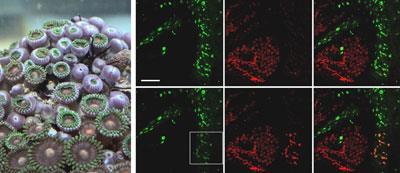Green fluorescent marker protein found in exotic marine animals can convert light into chemical energy
Scientists have discovered that a glowing protein found in some exotic marine animals and used widely as a ’marker’ in molecular biology has another remarkable property - it can convert light into chemical energy, a phenomenon usually associated with photosynthesis in plants or energy production in bacteria. Experts believe that such a protein is unprecedented in animals.
Green fluorescent protein (GFP) was originally discovered in a species of jellyfish. The molecule emits green light when it is irradiated with blue light and has become ubiquitous in biological research as a ’marker’ of gene expression - its gene can be fused with other genes of interest so that when the latter are switched on, GFP is manufactured by the cell and can easily be detected. But no-one knows the actual function of this family of proteins in nature.

Now, a group led by Konstantin Lukyanov of the Shemiakin-Ovchinnikov Institute of bioorganic chemistry in Moscow has shown that upon exposure to light, GFP can donate electrons to nearby chemical and biological electron acceptors.
It was known that the oxidised form of GFP emits red fluorescence. Lukyanov and his team attached the protein to metal beads and placed them in a solution containing a range of electron acceptors. When they exposed the protein to blue light it first turned green, then gradually became red, indicating that it was shedding electrons.
They repeated the experiment with the protein in living cells, which contain a range of natural electron accepting molecules. Again, the scientists saw the green protein turn to red as it donated electrons to acceptors within the cell. Electron transport is a fundamental process in living systems, and this newly discovered property of GFP could give clues to its function in nature.
’Fluorescent proteins of this type are generally considered to be passive light absorbers and emitters, whose function is associated with this property, such as causing bioluminescence,’ says Lukyanov. ’From our work it seems that GFP’s natural function might be as a light-activated electron donor - similar to the way that chlorophyll donates electrons to an acceptor in photosynthesis, or bacterial rhodopsin creates a proton gradient. It is pure speculation at this stage, but it is exciting.’
Alexander Ruban, a biological chemist at Queen Mary, University of London in the UK, believes that the work is highly significant. ’This is a very exciting discovery,’ he says. ’I think this might be the first example of such a photoactive protein in animals - you could even call it animal photosynthesis. It is a much more interesting molecule than we thought, and one could envisage it being used as a method to track the redox state of electron transfer pathways in living systems.’
Simon Hadlington
References
DOI: 10.1038/nchembio.174






No comments yet